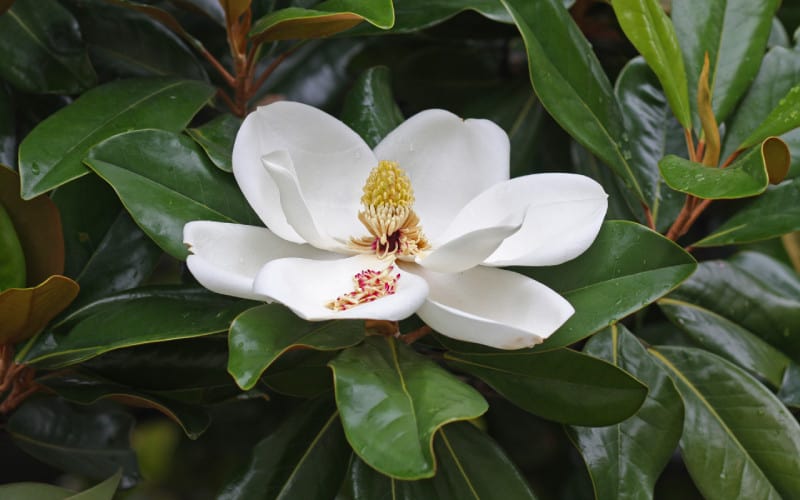Southern Magnolia Facts
- The Southern Magnolia represents a species of tree native to the southeastern portions of the continent on which it evolved. Furthermore, this stunning species of flora probably remains best known for the numerous large, highly fragrant flowers it produces.
- This gorgeous species further remains cultivated in warmer climates throughout the world. As a result, experts have to date developed more than 50 cultivars from this beautiful plant species. Also, the first known export of this species to other regions occurred in 1726.
- In addition, the wood of the Southern Magnolia also remains extremely popular in the commercial industry. Common uses for it include veneer, pallets, and furniture. The magnificent species forms the largest of more than 200 species of magnolia within its genus.
- Quite fortunately, its population appears to be sufficiently stable. This holds especially true due to its wide dispersal around the world. Therefore, the IUCN currently lists it as Least Concern on its Red List. But, it certainly faces the danger of climate change, like most species.
Related Articles
Southern Magnolia Physical Description
The truly gorgeous Southern Magnolia ranks as a medium to large species of evergreen tree. In addition, exceptional specimens of this plant can attain a height of as much as 120 ft (35.5 m). More specifically, the largest known specimen of this marvelous tree in existence stands 122 ft (37 m) in height.
This breathtaking tree also generally produces a single, quite sturdy trunk. furthermore, that feature itself generally develops a roughly pyramid-shaped structure. The leaves of the tree also grow comparatively large and broad. These average about 8 in (20 cm) in length, and 5 in (12.5 cm) wide.
The magnificent flowers of the Southern Magnolia also possess a strong natural citronella scent. These further grow as large as 12 in (30 cm) in diameter when in bloom. The fruit remains inedible and filled with large, bright red seeds. This also averages about 4 in (10 cm) long, and 2 in (5 cm) in width.
- Kingdom: Plantae
- Phylum: Angiosperms
- Class: Magnoliids
- Order: Magnoliales
- Family: Magnoliaceae
- Genus: Magnolia
- Species: M. grandiflora
Southern Magnolia Distribution, Habitat, and Ecology
To be completely precise, the magnificent Southern Magnolia seems to be specifically endemic to the southeastern United States. Furthermore, this limited range also roughly follows the southeast to southern coasts of the country. But, that range also extends from Virginia to Florida, and then westerly to Oklahoma and east Texas.
Furthermore, in the wild, the beautiful variety of tree typically occurs in a very specific and uncommon type of habitat. This distinct and less than common habitat consists of areas along the edges of swamps and moderate to large bodies of water. In addition, the wonderful tree also usually grows larger in more sheltered habitats.
Also, along the coastline, the Southern Magnolia rarely grows larger than the size of a large variety of shrub. In Florida, it adapted to a somewhat different habitat. As a result, it appears there in wooded floodplains, hummocks, and along ravines. It grows best in regions of high moisture content combined with adequate drainage.
Species Sharing Its Range
Check out our other articles on Fabulous Herbaceous Planets Named After Animals, Indian Bullfrog, Mount Erebus, Lava Cactus, Tassled Scorpionfish, Olive Ridley Sea Turtle, Kakapo

